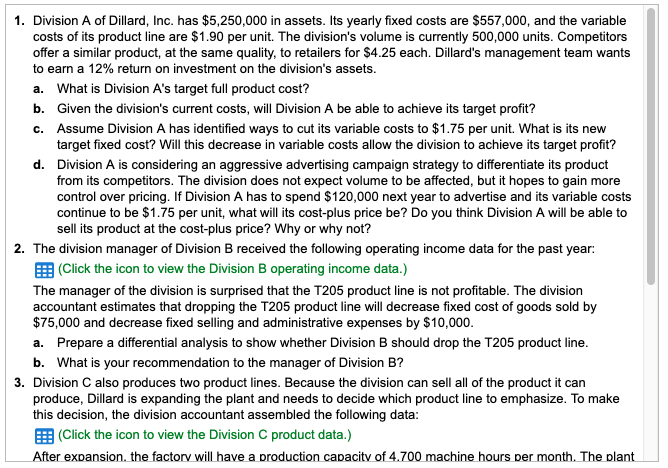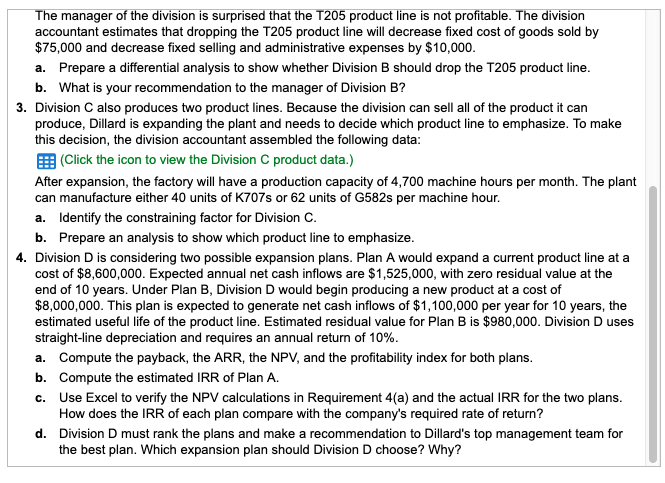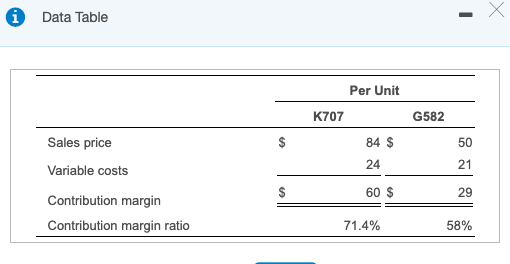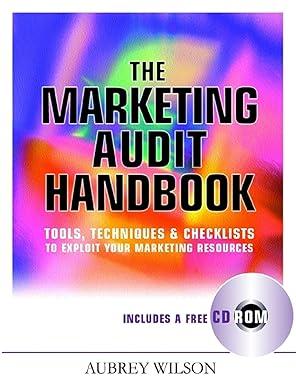







1. Division A of Dillard, Inc. has $5,250,000 in assets. Its yearly fixed costs are $557,000, and the variable costs of its product line are $1.90 per unit. The division's volume is currently 500,000 units. Competitors offer a similar product, at the same quality, to retailers for $4.25 each. Dillard's management team wants to earn a 12% return on investment on the division's assets What is Division A's target full product cost? a. b. c. Given the division's current costs, will Division A be able to achieve its target profit? Assume Division A has identified ways to cut its variable costs to $1.75 per unit. What is its new target fixed cost? Will this decrease in variable costs allow the division to achieve its target profit? d. Division A is considering an aggressive advertising campaign strategy to differentiate its product from its competitors. The division does not expect volume to be affected, but it hopes to gain more control over pricing. If Division A has to spend $120,000 next year to advertise and its variable costs continue to be $1.75 per unit, what will its cost-plus price be? Do you think Division A will be able to sell its product at the cost-plus price? Why or why not? 2. The division manager of Division B received the f ollowing operating income data for the past y r. EE (Click the icon to view the Division B operating income data.) The manager of the division is surprised that the T205 product line is not profitable. The division accountant estimates that dropping the T205 product line will decrease fixed cost of goods sold by $75,000 and decrease fixed selling and administrative expenses by $10,000 a. Prepare a differential analysis to show whether Division B should drop the T205 product line b. What is your recommendation to the manager of Division B? 3. Division C also produces two product lines. Because the division can sell all of the product it can produce, Dillard is expanding the plant and needs to decide which product line to emphasize. To make this decision, the division accountant assembled the following data EE (Click the icon to view the Division C product data.) er expansion, the factory will have a production capacitv of 4.700 machine hours per month. The plant e manager of the division is surprised that the T205 product line is not profitable. The division accountant estimates that dropping the T205 product line will decrease fixed cost of goods sold by $75,000 and decrease fixed selling and administrative expenses by $10,000 a. Prepare a differential analysis to show whether Division B should drop the T205 product line b. What is your recommendation to the manager of Division B? 3. Division C also produces two product lines. Because the division can sell all of the product it can produce, Dillard is expanding the plant and needs to decide which product line to emphasize. To make this decision, the division accountant assembled the following data EE (Click the icon to view the Division C product data.) After expansion, the factory will have a production capacity of 4,700 machine hours per month. The plant can manufacture either 40 units of K707s or 62 units of G582s per machine hour. a. Identify the constraining factor for Division C b. Prepare an analysis to show which product line to emphasize 4. Division D is considering two possible expansion plans. Plan A would expand a current product line at a cost of $8,600,000. Expected annual net cash inflows are $1,525,000, with zero residual value at the end of 10 years. Under Plan B, Division D would begin producing a new product at a cost of $8,000,000. This plan is expected to generate net cash inflows of $1,100,000 per year for 10 years, the estimated useful life of the product line. Estimated residual value for Plan B is $980,000. Division D uses straight-line depreciation and requires an annual return of 10% a. Compute the payback, the ARR, the NPV, and the profitability index for both plans b. Compute the estimated IRR of Plan A. c. Use Excel to verify the NPV calculations in Requirement 4(a) and the actual IRR for the two plans How does the IRR of each plan compare with the company's required rate of return? Division D must rank the plans and make a recommendation to Dillard's top management team for the best plan. Which expansion plan should Division D choose? Why? d. Division B of Dillard, Inc Income Statement For the Year Ended December 31, 2018 Product Line Total T205 B179 Net Sales Revenue $ 310,000 $ 360,000 $ 670,000 Cost of Goods Sold 31,000 275,000 306,000 4,000 44,000 75,000 67,000 342,000 111,000 417,000 249,000 253,000 Variable Fixed Total Cost of Goods Sold Gross Profit Selling and Administrative Expenses: Variable 80,000 148,000 27,000 74,000 107,000 222,000 $ (111,000) $ 142,000 $ 31,000 68,000 47,000 115,000 Fixed Total Selling and Administrative Expenses Operating Income (Loss) Data Table Per Unit K707 G582 Sales price Variable costs Contribution margin Contribution margin ratio 84 $ 24 50 21 29 58% 60 $ 71.4% Requirement 1. Division A of Dillard, Inc. has $5,250,000 in assets. Its yearly fixed costs are $557,000, and the variable costs of its product line are $1.90 per unit. The division's volume is currently 500,000 units. competitors offer a similar product at the same quality, to retailers for $425 each Dillard's management team wants to eam a 12% return on investment on the division's assets. 1a. What is Division A's target full product cost? $ 2,125,000 630,000 Revenue at current market price Less: Desired profit Target full product cost 1b. Given the division's current costs, will Division A be able to achieve its target profit? Begin by calculating Division A's current full product cost. Current fixed costs Plus: Current variable costs Current full product cost Division A's current full product costs are higher than its target full product cost, therefore Division A will not be able to acheive its target profit. 1,495,000 S 557,000 950,000 S 1,507,000 1c. Assume Division A has identified ways to cut its variable costs to $1.75 per unit. What is its new target fixed cost? Will this decrease in variable costs allow the division to achieve its target profit? Begin by calculating Division A's new target fixed cost. Target full product cost Less: Variable costs Target fixed cost Will this decrease in variable costs allow the company to achieve its target profit? 1,495,000 875,000 $ 620,000 1d. Division A is considering an aggressive advertising campaign strategy to differentiate its product from its competitors. The division does not expect volume to be affected, but it hopes to gain more control over pricing. If Division A has to spend $120,000 next year to advertise and its variable costs continue to be $1.75 per unit, what will its cost-plus price be? Do you think Division A will be able to sell its product at the cost-plus price? Why or why not? Begin by calculating the cost-plus price per unit. (Round your answer to the nearest cent.) Fixed costs Plus: Full product cost Plus: Target revenue Divided by: Number of units Cost-plus price per unit Do you think Division A will be able to sell its product at the cost-plus price? Why or why not? If the advertising campaign is effective, Division A should be able to sell its product at this price because it is not significantly higher than the $4.25 charged by competitors 677,000 875,000 S 1,552,000 630,000 $ 2,182,000 500,000 4.36 Current variable costs Desired profit 2a. Prepare a differential analysis to show whether Division B should drop the T205 product line. (Enter decreases to profits with a parentheses or minus sign.) in operating income 1. Division A of Dillard, Inc. has $5,250,000 in assets. Its yearly fixed costs are $557,000, and the variable costs of its product line are $1.90 per unit. The division's volume is currently 500,000 units. Competitors offer a similar product, at the same quality, to retailers for $4.25 each. Dillard's management team wants to earn a 12% return on investment on the division's assets What is Division A's target full product cost? a. b. c. Given the division's current costs, will Division A be able to achieve its target profit? Assume Division A has identified ways to cut its variable costs to $1.75 per unit. What is its new target fixed cost? Will this decrease in variable costs allow the division to achieve its target profit? d. Division A is considering an aggressive advertising campaign strategy to differentiate its product from its competitors. The division does not expect volume to be affected, but it hopes to gain more control over pricing. If Division A has to spend $120,000 next year to advertise and its variable costs continue to be $1.75 per unit, what will its cost-plus price be? Do you think Division A will be able to sell its product at the cost-plus price? Why or why not? 2. The division manager of Division B received the f ollowing operating income data for the past y r. EE (Click the icon to view the Division B operating income data.) The manager of the division is surprised that the T205 product line is not profitable. The division accountant estimates that dropping the T205 product line will decrease fixed cost of goods sold by $75,000 and decrease fixed selling and administrative expenses by $10,000 a. Prepare a differential analysis to show whether Division B should drop the T205 product line b. What is your recommendation to the manager of Division B? 3. Division C also produces two product lines. Because the division can sell all of the product it can produce, Dillard is expanding the plant and needs to decide which product line to emphasize. To make this decision, the division accountant assembled the following data EE (Click the icon to view the Division C product data.) er expansion, the factory will have a production capacitv of 4.700 machine hours per month. The plant e manager of the division is surprised that the T205 product line is not profitable. The division accountant estimates that dropping the T205 product line will decrease fixed cost of goods sold by $75,000 and decrease fixed selling and administrative expenses by $10,000 a. Prepare a differential analysis to show whether Division B should drop the T205 product line b. What is your recommendation to the manager of Division B? 3. Division C also produces two product lines. Because the division can sell all of the product it can produce, Dillard is expanding the plant and needs to decide which product line to emphasize. To make this decision, the division accountant assembled the following data EE (Click the icon to view the Division C product data.) After expansion, the factory will have a production capacity of 4,700 machine hours per month. The plant can manufacture either 40 units of K707s or 62 units of G582s per machine hour. a. Identify the constraining factor for Division C b. Prepare an analysis to show which product line to emphasize 4. Division D is considering two possible expansion plans. Plan A would expand a current product line at a cost of $8,600,000. Expected annual net cash inflows are $1,525,000, with zero residual value at the end of 10 years. Under Plan B, Division D would begin producing a new product at a cost of $8,000,000. This plan is expected to generate net cash inflows of $1,100,000 per year for 10 years, the estimated useful life of the product line. Estimated residual value for Plan B is $980,000. Division D uses straight-line depreciation and requires an annual return of 10% a. Compute the payback, the ARR, the NPV, and the profitability index for both plans b. Compute the estimated IRR of Plan A. c. Use Excel to verify the NPV calculations in Requirement 4(a) and the actual IRR for the two plans How does the IRR of each plan compare with the company's required rate of return? Division D must rank the plans and make a recommendation to Dillard's top management team for the best plan. Which expansion plan should Division D choose? Why? d. Division B of Dillard, Inc Income Statement For the Year Ended December 31, 2018 Product Line Total T205 B179 Net Sales Revenue $ 310,000 $ 360,000 $ 670,000 Cost of Goods Sold 31,000 275,000 306,000 4,000 44,000 75,000 67,000 342,000 111,000 417,000 249,000 253,000 Variable Fixed Total Cost of Goods Sold Gross Profit Selling and Administrative Expenses: Variable 80,000 148,000 27,000 74,000 107,000 222,000 $ (111,000) $ 142,000 $ 31,000 68,000 47,000 115,000 Fixed Total Selling and Administrative Expenses Operating Income (Loss) Data Table Per Unit K707 G582 Sales price Variable costs Contribution margin Contribution margin ratio 84 $ 24 50 21 29 58% 60 $ 71.4% Requirement 1. Division A of Dillard, Inc. has $5,250,000 in assets. Its yearly fixed costs are $557,000, and the variable costs of its product line are $1.90 per unit. The division's volume is currently 500,000 units. competitors offer a similar product at the same quality, to retailers for $425 each Dillard's management team wants to eam a 12% return on investment on the division's assets. 1a. What is Division A's target full product cost? $ 2,125,000 630,000 Revenue at current market price Less: Desired profit Target full product cost 1b. Given the division's current costs, will Division A be able to achieve its target profit? Begin by calculating Division A's current full product cost. Current fixed costs Plus: Current variable costs Current full product cost Division A's current full product costs are higher than its target full product cost, therefore Division A will not be able to acheive its target profit. 1,495,000 S 557,000 950,000 S 1,507,000 1c. Assume Division A has identified ways to cut its variable costs to $1.75 per unit. What is its new target fixed cost? Will this decrease in variable costs allow the division to achieve its target profit? Begin by calculating Division A's new target fixed cost. Target full product cost Less: Variable costs Target fixed cost Will this decrease in variable costs allow the company to achieve its target profit? 1,495,000 875,000 $ 620,000 1d. Division A is considering an aggressive advertising campaign strategy to differentiate its product from its competitors. The division does not expect volume to be affected, but it hopes to gain more control over pricing. If Division A has to spend $120,000 next year to advertise and its variable costs continue to be $1.75 per unit, what will its cost-plus price be? Do you think Division A will be able to sell its product at the cost-plus price? Why or why not? Begin by calculating the cost-plus price per unit. (Round your answer to the nearest cent.) Fixed costs Plus: Full product cost Plus: Target revenue Divided by: Number of units Cost-plus price per unit Do you think Division A will be able to sell its product at the cost-plus price? Why or why not? If the advertising campaign is effective, Division A should be able to sell its product at this price because it is not significantly higher than the $4.25 charged by competitors 677,000 875,000 S 1,552,000 630,000 $ 2,182,000 500,000 4.36 Current variable costs Desired profit 2a. Prepare a differential analysis to show whether Division B should drop the T205 product line. (Enter decreases to profits with a parentheses or minus sign.) in operating income














